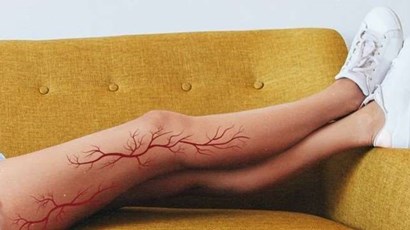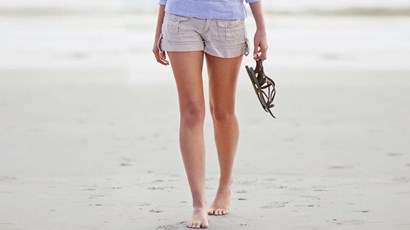How to treat varicose veins

Spider veins: why is winter leg care so important?
Spider veins are a common condition and are usually no cause for concern. However, it's important to look after our vein health during winter, as cold weather can affect the flow of blood through our veins, increasing the risk of leg complaints and discomfort.
Spider veins: a common occurence
If you have noticed small, spider-like lines in blue, purple, or red appearing on your legs or face, then you are probably one of the many people who have spider veins. It may please you to hear that there is no need for alarm, as spider veins are so common that experts consider them to represent 'the norm'.
Spider veins have a higher occurrence in women, but it's worth noting that prevalence in both men and women is high. One study of 1,566 people diagnosed spider veins in 88% of women and 79% of men.
If you don't have spider veins and are now wondering why, it could be down to your age, as most people first notice these thin lines between 30 and 50 years. Regardless of whether you currently have spider veins or not, many studies conclude that the majority of adults will develop spider veins at some point in their lives.
What are spider veins?
"Spider veins are small, dilated blood vessels that are visible through the skin," explains Professor Mark Whiteley, consultant venous surgeon and founder of The Whiteley Clinic.
"They may be red, purple or blue and most often appear on the legs or face in the form of thin lines, webs or branches. People often refer to them as 'thread veins' although they are called 'telangiectasia' medically."
Spider veins are different to varicose veins, which are larger and protrude from the legs. These two common venous conditions also occur for different reasons, as Dr Whiteley describes: "Varicose veins occur when the valves in our veins stop working properly, meaning the blood falls down the veins when standing up, rather than flowing upwards towards the heart (chronic venous insufficiency).
"Spider veins can occur for different reasons. The commonest is when pressure from underlying hidden varicose veins allows blood to fall into the surface veins, dilating them and making them visible. Sometimes this is from a high pressure 'incompetent perforator' vein (veins that prevent backflow of blood down to other veins) in the lower leg.
"In both cases, valves inside the veins stop working properly allowing blood to fall back down the leg and pool in the veins under the skin. Therefore, spider veins on the legs are almost always due to underlying hidden varicose veins or incompetent perforator veins."
When should I be worried about spider veins?
The good news is most people who have spider veins don't experience any significant medical symptoms or complications. Most complaints are purely aesthetic, as some people don't like how they look.
Unfortunately, the appearance of these small, spider-like lines can make some feel self-conscious, leading people to cover the affected areas or even avoid certain social occasions. One study found that 17% of 223 people with spider veins met the criteria for a body dysmorphic disorder diagnosis. If spider veins are impacting your life in this way, there are cosmetic treatment options to reduce their visibility.
More rarely, people with spider veins complain of symptoms including leg fatigue, cramps, itching, or burning.
Dr. Whiteley advises that people with spider veins also have a small risk of developing other health complications, although this is because they have common risk factors, not because spider veins are themselves a direct cause of the complications. These include:
- Eczema.
- Skin damage.
- Blood clots.
- Leg ulcers.
- Superficial venous thrombosis/'phlebitis' (a blood clot in the superficial veins).
- Deep vein thrombosis (a blood clot in the deep veins).
Can cold weather cause spider veins?
Simply put, there is no evidence to suggest that cold weather causes spider veins. This said, we can look after our venous health during the winter months when temperatures drop and affect our circulation. In terms of veins, this means that it's important to move our legs to pump blood back to the heart.
"The cold weather can slow down the rate at which blood is pumped around the body as the arteries and blood vessels become more constricted," says Dr Whiteley. "However, there are easy ways to improve circulation in the winter months, such as following a simple exercise plan or wrapping up warm."
Dr Whiteley goes on to explain that exercise increases the amount of blood flow down the arteries which keeps them healthy by the release of nitric oxide into the arterial wall. In addition, movement makes the muscle pumps in the leg contract, which in turn pumps the venous blood back to the heart.
"The faster the flow of blood in the veins, the less chance of blood clotting (such as superficial venous thrombosis and deep vein thrombosis) and of inflammation caused by venous stasis. This in turn reduces the chances of aching of the legs, leg swelling, damage to the skin such as eczema, brown stains (haemosiderin), and leg ulceration."
How to prevent varicose veins
Varicose veins will affect nearly one third of us at some point in our lives. For those who do d...
What lifestyle changes can reduce your risk of complications?
It's important to note that lifestyle changes can't prevent us from developing spider veins. However, there are benefits to looking after our venous health. This is especially true over winter, when cold weather can lead to poorer venous circulation, and when we tend to become more sedentary.
"Research seems to show that lifestyle changes make little or no difference to getting spider veins or varicose veins, as the failure of the venous valves runs in families," explains Dr Whiteley.
"However, there is good evidence that regular exercise reduces how quickly the problem deteriorates and reduces the risks of complications from varicose veins, including aching, eczema, skin damage, clots and leg ulcers."
Numerous studies also suggest that obesity, lack of physical exercise, and prolonged sitting increase the risk of chronic venous insufficiency, an underlying cause of both spider veins and varicose veins.
Dr Whiteley's winter guide to good vein health
Physical activity
"It is important to stay active in the colder months as this can helps the blood flow and keeps people warm. This is especially important if you have a sedentary job during the winter months.
"Muscles in the legs help your veins push blood back to the heart, against the force of gravity. If you have varicose veins or spider veins in your legs, any exercise that works the muscles in your legs will help prevent clots and reduce the rate of deterioration."
- Walking - the best exercise for leg veins.
- Yoga - a low-impact exercise that's particularly good at improving circulation. The bending and stretching movements help to compress and decompress the blood vessels, which can help to boost circulation.
- Water exercises - the water gives the veins external support.
- Not sitting or standing for too long.
"Standing or sitting for long periods of time can make it harder for your blood to travel in the leg veins against gravity. This causes an increase in pressure in the veins, resulting in blood beginning to pool around the ankles.
"Regularly moving around will help to decrease this venous pressure. If you have to sit or stand at work or home for a long time, take a break every 30 minutes to stand up and walk around."
Weight loss
"Extra weight seems to make it more difficult for your veins to move blood back up to your heart, against the force of gravity. Losing weight may prevent varicose veins or spider veins from worsening so quickly."
Wearing compression stockings
"Compression stockings help increase blood flow from your legs and can be very useful if you are in a sedentary job, are unable to walk regularly, or are travelling."
Putting your feet up
"Rest your feet on a stool as much as possible when sitting to help the blood in your legs flow back to your heart. Alternatively, you can wiggle your ankles.
"It may sound simple, but elevating your legs is effective for improving venous circulation. Raising your legs when sitting will help to lower the pressure in your legs by allowing blood that has pooled to drain away, helping to prevent blood clots."



